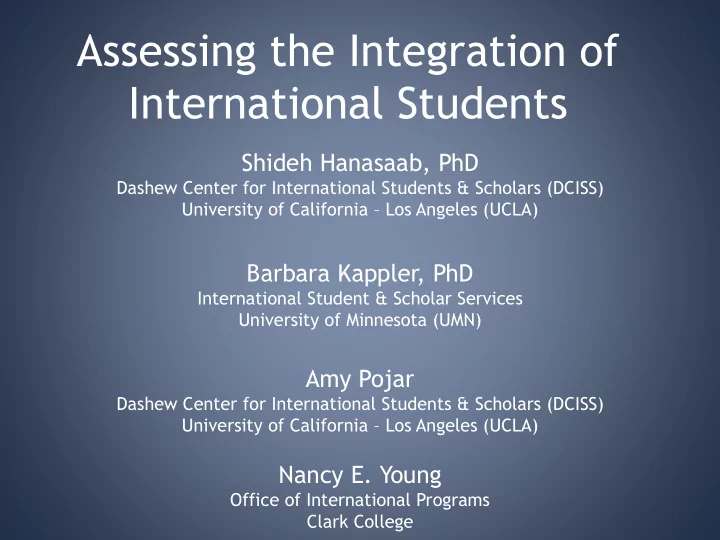

Assessing the Integration of International Students Shideh Hanasaab, PhD Dashew Center for International Students & Scholars (DCISS) University of California – Los Angeles (UCLA) Barbara Kappler, PhD International Student & Scholar Services University of Minnesota (UMN) Amy Pojar Dashew Center for International Students & Scholars (DCISS) University of California – Los Angeles (UCLA) Nancy E. Young Office of International Programs Clark College
Session Objectives • Examine the assessment cycle in practice through assessment projects on student integration • Understand the value of utilizing research and assessment in the context of international student and scholar services • Develop an assessment plan around key areas of concern at your campus
Assessment Cycle & Defining Purpose
Outcome/ Phenomenon of Interest Use & Share Results Define Assessment Purpose How can the Articulate a results guide clear The change in the question to future? answer Assessment Cycle Analyze & Report Create an Assessment Plan Select a method best Conduct the suited to assessment answer the question Collect Data
Defining Assessment Purpose Departmental Departmental Mission Outcomes Division Program Goals Mission/Goals Outcome/ Phenomenon of Interest
Articulating Questions
Articulating Question(s) Mission Goals Outcomes Question(s)
Articulating Question(s) Social Networks Interactions Across Difference Integration Utilization of Campus Resources Program Impact & Outcomes International Impact on Domestic Peers
Using & Sharing Results
Using & Sharing Results
Using & Sharing Results Question common • assumptions Identify opportunities • for additional support Catalyze discussion • about best practices Encourage referrals to • DCISS programs and other key campus services
Examples
Friendship Network Co-nationals UG Int'l (not co- n = 795 national) Domestic/U.S. Mixed G n = 782 None 0% 20% 40% 60% 80% 100% 2014 DCISS Biennial Survey
Interaction Across Difference Undergraduate Students Shared a meal/socialized In class Always/Most of the time Outside of class (academic) Sometimes UCLA extracurricular Rarely/Never Different backgrounds Different opinions 0% 50% 100% 2014 DCISS Biennial Survey
Interaction Across Difference Graduate Students Shared a meal/socialized In class Always/Most of the time Outside of class (academic) Sometimes UCLA extracurricular Rarely/Never Different backgrounds Different opinions 0% 50% 100% 2014 DCISS Biennial Survey
Where or with whom do you feel you have developed a sense of community or social support at UCLA? Undergraduate Students, n = 380 97% report some form of community/support 1. Friends 2. Clubs & student organizations 3. People/spaces associated with academics 4. People/spaces associated with housing
Where or with whom do you feel you have developed a sense of community or social support at UCLA? Graduate Students, n = 363 93% report some form of community/support 1. People/spaces associated with academics 2. Friends
Program Outcomes • 91% of respondents connect with at least one person at a given DCISS event • 65% of respondents connect with at least one person after the event • Most of the after-event connections are with at least one domestic peer • 94% of respondents learned about another culture through events/people attending • 93% of respondents feel more comfortable at UCLA because of the event(s) they attended
Utilization Data • Benchmarking • Identifying campus resources utilized & underutilized • Pairing with other assessment questions to understand if those in need are finding matching resources (e.g. CAPS, Financial) • Identifying spaces where there may be more/less international student presence and impact
Final Thoughts
An interview with Nancy E. Young & Barbara Kappler Mikk 21
22
What Is Integration? Integration is an intentional process to create community, by encouraging domestic and international students to engage with each other in ongoing interaction, characterized by mutual respect, responsibility, action, and commitment. Definition developed by Nancy E. Young and the University of Minnesota’s Project Advisory Group: Barbara Kappler, Gayle Woodruff, Alisa Eland, Beth Isensee, Diana Yefanova, and Xi Yu. 23
Successful integration in a higher educational context is characterized by: • active facilitation, support, and modeling by faculty, staff, and administration in the curricular and co-curricular contexts • an academic climate that recognizes and reflects the goals and values of inclusion • assessment, evaluation, and mindful reflection of intercultural and global competence at all levels of the institution (individual, classroom, school, institution-wide) • movement from “contact with” and “celebration of” cultures to deeper layers of engagement and enrichment, leading to the creation of common ground • commitment to and recognition of the mutual benefits of such engagement • a sense of belonging, contributing, and being valued Developed by Nancy E. Young and the University of Minnesota’s Project Advisory Group made up of Barbara Kappler, Gayle Woodruff, Alisa Eland, Beth Isensee, Diana Yefanova, and Xi Yu. 24
Context, Stakeholders, Lessons Learned… 25
Limited Resources & Extending the Shelf Life 26
Tips 27
U of MN Reports • Report summaries: http://global.umn.edu/icc/umntc-ugis- data • Best Practices on Integrating International and Domestic Students: http://global.umn.edu/icc/documents/14_integration_best _practices_overall.pdf • Educational Impact of International Students on Campus: http://global.umn.edu/icc/documents/15_EducationalImp act-IntlStudents.pdf 29
Recommend
More recommend